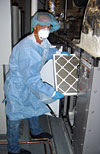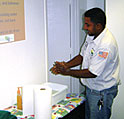
The
contractor’s containment protocol during maintenance and service includes
baseline airborne sampling and reporting, and when filters are changed, the
company contains the dust and dirt.
He’s not a germaphobe; but the chief operating officer of Innovative Service Solutions (ISS), a 3.6 million dollar service contractor, understands protecting his clients and employees from infectious disease is an investment in them. Bodwell said the health care market makes up 15-20 percent of the company’s business mix.
Hand washing is just part of the company’s much larger, overall plan to reduce risks for both the client and its own employees. “Every truck is stocked with disposable rubber gloves just like the doctor will wear.” said Bodwell, “and two different types of masks depending on the environment where they’re working.”
If they are working in a wet environment where exposure to Legionella could occur, the mask is similar to a respirator. “If we are working in a surgical suite, our mask is a medically approved disposable mask,” Bodwell said. “Depending on where in a health care facility we are working, our technicians could be wearing one of our full paper disposable jumpsuits, or a surgical gown provided by the facility.
“We train our team to keep bacteria off the body and body openings: eyes, ears, mouth, nose, and the lower extremities,” he said.
A training program called S.T.A.T (for Specialized Technical Awareness Training) is taught twice a year, “or any time we are introducing a technician to the health care market, or when sharing the safety requirements of a new client.” Facilities like nursing homes, for example, require twice-yearly regulatory compliance testing.
Regular adherence to best practices, Bodwell said, requires nothing less than “constant, top-of-mind awareness” in risk management, infection control, and medical understanding.
This keen awareness also helps the contractor’s clients meet Joint Commission on Accreditation of Healthcare Organizations (JCAHO) Environment of Care Standards. Their compliance criteria address risk management of infection control, and exposure to airborne and waterborne pathogens in health care facilities.

Innovative
Service Solutions (ISS) states that it takes equipment integrity and traffic
flow (of staff, visitors, and patients) into account. It also follows a
containment protocol during maintenance and service.
MARKET ENTRANCE
The contractor is still a relative newcomer to the health care market. ISS entered this market just a few years ago, when the company identified different niches that seemed likely to be more resistant to a poor economy. The contractor remains active in the commercial-industrial service markets, including food processing and packaging, where similar guidelines dictate the practice of good hygiene and prevention to minimize the growth of bacteria.Some market truths emerged from the brainstorming: “Florida has old people, and people will continue to get sick.” (“We don’t actively pursue the nursing home market,” Bodwell said; “in fact, we avoid them because they tend to be slow payers. I do provide training for in-house maintenance staff because they need to implement best practices in their facilities, and to stay in front of them as equipment ages and repairs exceed their in-house capabilities.”)
In 2007, ISS started looking at surgical centers, which Bodwell said was a hard market to get into. The company contacted market consultant Marlene Linders, president and CEO of Philders Group International Inc., of the Linders Health Institute, Heathrow, Fla. “We put together a marketing program primarily for health care,” Bodwell said. This included technician training and a PowerPoint presentation targeted at owners and risk managers.
Because the contractor does not offer new construction, there was no plan specifically for hospitals. “We targeted surgical centers, ambulatory centers, imaging centers, and other health care facilities detached from the hospitals.”
According to Bodwell, Linders “taught us to think like the risk management personnel in health care facilities. This starts by recognizing that the patients have compromised immune systems, and they are susceptible to infectious disease, and that the cost of prevention is less than the cost of a lawsuit brought on by a patient.
“There is no doubt our eyes were closed before recognizing that IAQ and Legionella were only a starting point with infection control and containment,” he said. “We became aware of air movement throughout the building.”
“We talk about pressures, filtration, all aspects of our industry, and apply it in this market,” Bodwell said. Building pressurization in particular is a key part of an overall strategy for containment, he explained: “You want a slight positive pressure on the building so the outside air is not getting in; however in containment, a negative pressure and proper filtration is desirable.”
To facilitate communication with and the education of its clients, the company also holds lunch and learns for them. At other times, “I am the speaker at their lunches,” Bodwell said. In a nursing home for instance, he might talk about the importance of cleaning ice machines.

Contractor
Ken Bodwell, chief operating officer of Innovative Service Solutions (ISS),
regularly presents an hour-long session on how techs should wash their hands
using the correct type of soaps.
BEST PRACTICES, TRAINING
For health care and other mission critical clients, using best practices and keeping their priorities top of mind is the way the contractor provides the type of service they require. But it goes deeper than that in health care. “[We] acknowledge the importance of employee and patient safety, and protecting our clients’ interests in regard to their patients’ health, safety, and welfare by implementing service protocols directed at infection control,” the company states on its website.Working with a professional risk management consultant, the company developed a proactive training program (S.T.A.T.) and a planned maintenance program called ViceVRSA. The names themselves convey a special meaning to health care clients. In their lingo, “stat” is an abbreviation of the Latin word statim, meaning “immediately”; and VRSA sounds like “MRSA,” or multidrug-resistant Staphylococcus aureus, a bacteria that causes difficult-to-treat infections.
“Our guys are wearing masks and personal protection,” reiterated Bodwell. “People are starting to recognize our responsibility to take care of our technicians.” It also protects clients’ interests. “A hospital’s insurance accounts for more than 25 percent of its operating cost,” he said.
“Risk managers understand the importance,” because the contractor puts it into terms that these executives can relate to. But the key to this market, he said, is to get to the higher-level decision makers. “It goes way above the facility manager’s level.”
The company’s website states that it takes “an epidemiological approach” that include equipment integrity and traffic flow (of staff, visitors, and patients). It also follows a containment protocol during maintenance and service work. For example, baseline airborne sampling and reporting is part of its routine maintenance program, and when filters are changed, the company contains the dust and dirt.
Service may be more involved. “Let’s say you’ve got a ceiling retrofit,” Bodwell said; the crew may use a plastic barrier wall and pressurization to localize the effects of the work. Before old equipment is removed, it is wrapped. The company also uses HEPA vacuums, and employees wear proper personal protective equipment and disposable coverings.
And they wash their hands.
Sidebar: Vital Stats
ISS has 20 techs, and its customers include outpatient surgicenters, ambulatory care centers, outpatient cardiac cath labs, outpatient ophthalmology facilities, outpatient MRI clinics, and physician clinics.Bodwell has served as president of the Florida Air-Conditioning Contractors of America and presently sits on the FACCA board of directors. He also sits on the board of directors for the Indoor Air Quality Association of Central Florida.
For more information, visit www.innovativeservice solutions.com.
Publication date:11/01/2010

Report Abusive Comment